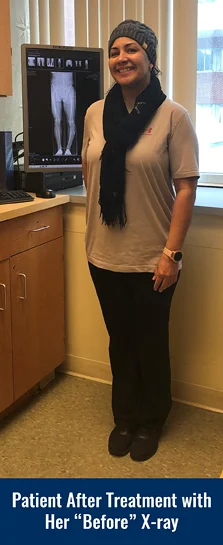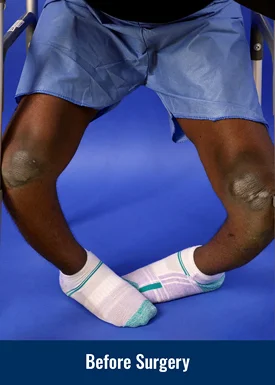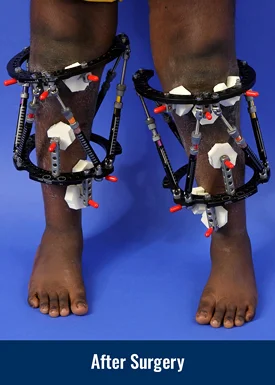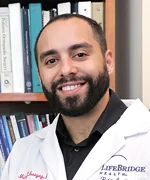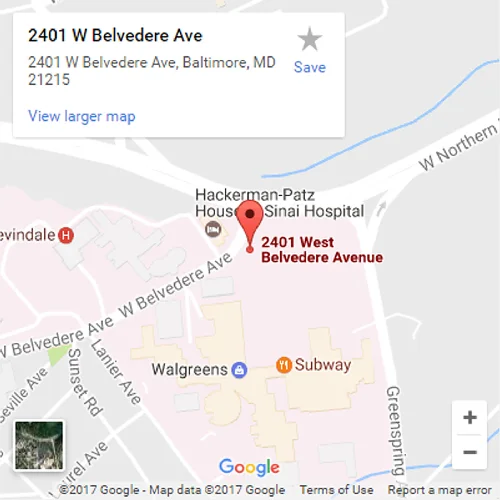Blount Disease
What is Blount disease?
Blount disease is a condition characterized by one side of the upper shin bone’s growth plate growing more slowly than the growth plate on the other side, resulting in a progressive bowing of the legs. The disease is usually due to a sick growth plate and is progressive, meaning that more bowing occurs as the child grows.
Blount disease is more common in overweight children and early walkers. It is also more common in girls, African American children and Hispanic children. It might be related to overloading the inner side of the knee. It is commonly confused with “physiological bowing” that occurs at an earlier age with mild, symmetrical bowing that resolves on its own. Blount disease, on the other hand, is usually diagnosed around the age of 2 or 3 years with asymmetric, more severe bowing of the legs that gets worse, not better, over time.
Children usually do not feel any symptoms, but concerned parents often notice their children are not walking like other children their age and that they have crooked legs.
What are the different types of Blount disease?
- Infantile Blount Disease
This form of Blount disease affects children before they are 4 years old. It is bilateral (in both legs) 50% of the time. It must be treated before the age of 3 and ½ to 4 years for treatment to be the most successful. - Adolescent Blount Disease
This form of Blount disease affects children over 10 years of age—especially overweight children. It is less common, often less severe, and more likely to be unilateral (in one leg).
How is Blount disease diagnosed?
To diagnose a child, the doctor examines the child, observes the child’s walk and evaluates the rotation and angular appearance of the leg. An X-ray is required for the diagnosis of the sick growth plate in the upper tibia and to measure the abnormal angulation of the leg bones.
What are the treatment options for Blount disease?
Non-operative treatment uses braces to unload the overloaded inner side of the knee. This treatment method is used in mild cases below the age of 3. Bracing may take up to 2 years and can be cumbersome.
There are several different surgical treatments:
- Corrective osteotomy: The bone is cut and the angulation is corrected. Metal wires are usually used to stabilize the cut bone and the patient is put in a plaster cast usually for 5 to 6 weeks. Alternatively, an external fixator may be used to hold the bones in the corrected position while they heal.
- Guided growth: The healthy side of the growth plate is restricted by using a small plate and two screws, giving a chance for the slow part to make up for the bow and straighten the leg again. This surgery is simple, and the growth arrest of the growth plate is reversible simply by removing the screws. In cases of rebound, the screws are put in again for correction. The surgery takes about 30 minutes and the child can walk immediately after surgery. The period of treatment depends on the amount of correction needed. The patient usually follows up every 4 months to monitor the gradual correction and the screws are removed when the legs are straightened out.
- Hemiplateau elevation: In severe cases where part of the joint line is depressed, the depressed part is elevated through a bone cut. Screws, metal wires or an external fixator are usually used to maintain correction until bone healing occurs in 5 to 6 weeks. During this time, the child wears a cast and cannot put weight on the leg.
- External fixation: When there is severe deformity, and especially when the leg is too short, external fixation is commonly used for treatment. The fixator is typically worn on the leg for 3 to 4 months.
Why choose the International Center for Limb Lengthening for treatment of Blount disease?
Limb lengthening and deformity correction are complex processes. Your doctor at the International Center for Limb Lengthening will take the time to make sure you understand all your options and then will customize your treatment to meet your specific needs. Our patients benefit from our team-centered approach with world-renowned surgeons and specialized physician assistants, nurses and physical therapists. We help patients with Blount disease achieve their best possible result.
Doctors who treat Blount disease
*Patients Over 16 Years Old Only
†Children and Adolescents/Young Adults Only


